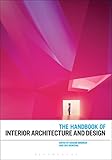The handbook of interior architecture and design / edited by Graeme Brooker and Lois Weinthal.
Material type: TextPublisher: London ; New York : Bloomsbury Academic, 2013Description: xvi, 676 pages, 16 unnumbered pages of plates : illustrations (some color) ; 25 cmContent type:
TextPublisher: London ; New York : Bloomsbury Academic, 2013Description: xvi, 676 pages, 16 unnumbered pages of plates : illustrations (some color) ; 25 cmContent type: - text
- unmediated
- volume
- 9781847887450
- 729 BR.H 2013 23
- NA2850 .H36 2013
| Item type | Current library | Collection | Call number | Status | Date due | Barcode | |
|---|---|---|---|---|---|---|---|
|
|
The Knowledge Hub Library | Engineering | 729 BR.H 2013 (Browse shelf(Opens below)) | Not For Loan | 193029 |
Included bibliographical reference (pages 569-643) and index
Part 1. Contexts: Introduction -- Part 1.1. Reflecting on the discipline: Modern history and interior design / Anne Massey -- Rethinking histories, canons, and paradigms / John C. Turpin -- Inhabited space: critical theories and the domestic interior / Alexa Griffith Winton -- Methods of research and criticality / Gennaro Postiglione -- Protected title in Britain: an educational necessity? / Graham Stretton -- Regulations and conventions: interior design practice and education / Kees Spanjers -- The profession that dare not speak its name / Drew Plunkett -- Part 1.2. Interior terrains : interiorizt / Suzie Attiwill -- Surface demonstrations, neutral, not so / Julieanna Preston -- A short history of the room / Fred Scott -- New occupancy / Lorraine Farrelly -- Program, function, and fabrication: exhibiting the domestic interior / Andy Milligan and Helen O'Connor -- Lives in large interiors / Thomas Kong -- Swiss cheese and beanbags: producing interior urbanism / Lee Stickells -- The public private interior: constructing the modern domestic interior in Singapore's public housing / Lilian Chee -- The evolution of workspace design: from the machine to the network / Jeremy Myerson -- Installation and performance / David Littlefield -- Exhibition design: reflections / David Dernie -- Part 2. Occupancy: Introduction -- Part 2.1. The body, behavior, and space : Redesigning for the body: users and bathrooms / Barbara Penner -- The selection, creation, and perception of interior spaces: an environmental psychology approach / Samuel D. Gosling, Robert Gifford, Lindsay McCunn -- Guilty by design/guilty by desire: queering bourgeois domesticity / John Potvin -- Toward sentience / Clive Parkinson -- Design for ageing-in-place for high-density living in Asia: a comparative analysis on residential design in Singapore, Japan, and Hong Kong / Ong Swee Hong -- Demographics and identity / Stephanie White -- Part 2.2. Ethics and the indoor environment: The thin edge of the wedge: shifting ethical terrains and interior design in the twenty-first century / Mary Anne Beecher -- Designing desire / Shonquis Moreno -- Designing for sustainability: a framework for interior designers to design for efficiency and beyond / Nadia Elrokhsy -- Interior design, a political discipline / Terry Meade -- Globalization: what shapes a global interior? / Alison B. Snyder -- Part 3. Representation and fabrication: Introduction -- The art of borrowing / Ro Spankie -- Model behavior / Nick Dunn -- Digital representation and fabrication / Igor Siddiqui -- The interior: television, gaming, and new media / Edward Hollis -- Literary narratives / Mark Taylor -- Part 3.1. Atmospheric conditions of the interior: Ornament and decoration / Jonathan Massey --The poetic language of interior materials and color / George Verghese, Dianne Smith -- Technology and the interior / Trevor Keeble -- Phenomenology and the senses in interiors / Christine Cantwell -- Taste and trends / Penny Sparke.
The Handbook of Interior Architecture and Design offers a compelling collection of original essays that seek to examine the shifting role of interior architecture and interior design, and their importance and meaning within the contemporary world. Interior architecture and interior design are disciplines that span a complexity of ideas, ranging from human behaviour and anthropology to history and the technology of the future. Approaches to designing the interior are in a constant state of flux, reflecting and adapting to the changing systems of history, culture and politics. It is this process that allows interior design to be used as evidence for identifying patterns of consumption, gender, identity and social issues. The Handbook of Interior Architecture and Design provides a pioneering overview of the ideas and arrangements within the two disciplines that make them such important platforms from which to study the way humans interact with the space around them. Covering a wide range of thought and research, the book enables the reader to investigate fully the changing face of interior architecture and interior design, while offering questions about their future trajectory.
There are no comments on this title.

